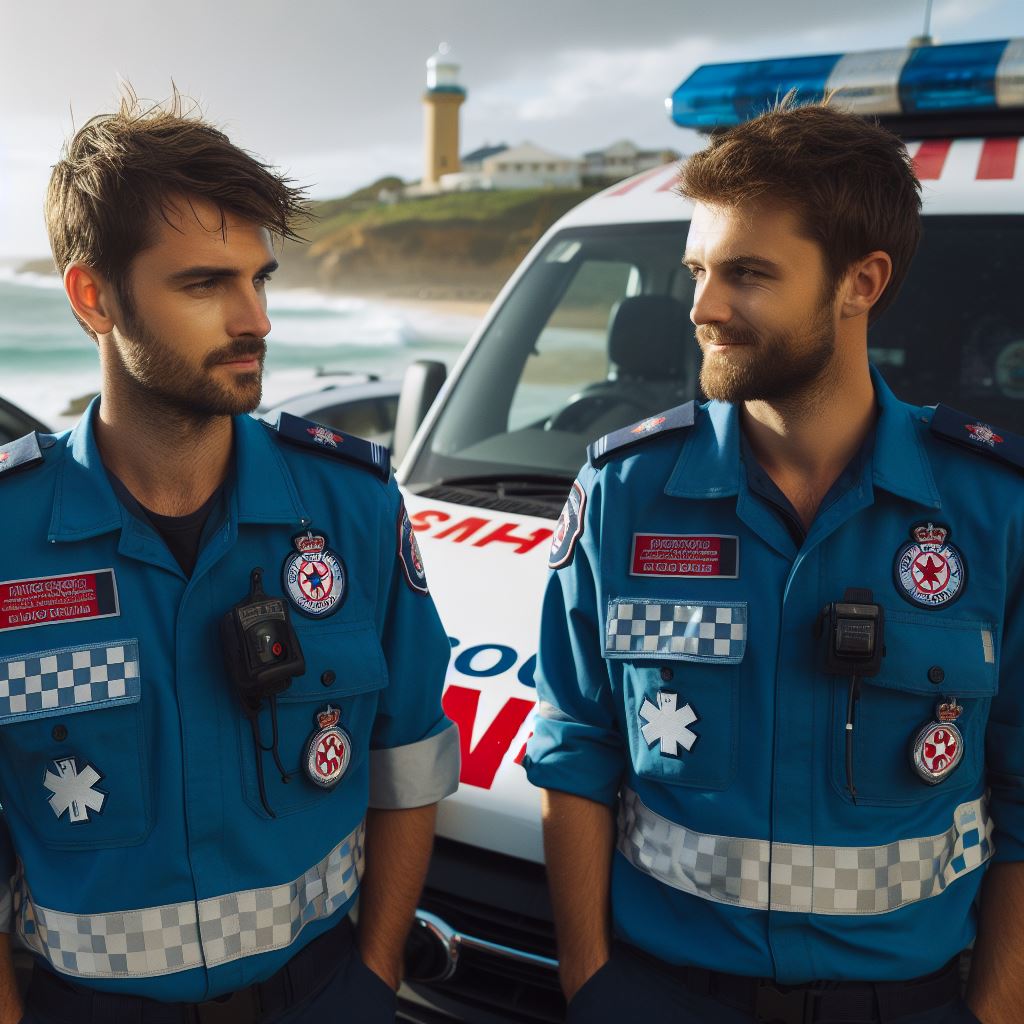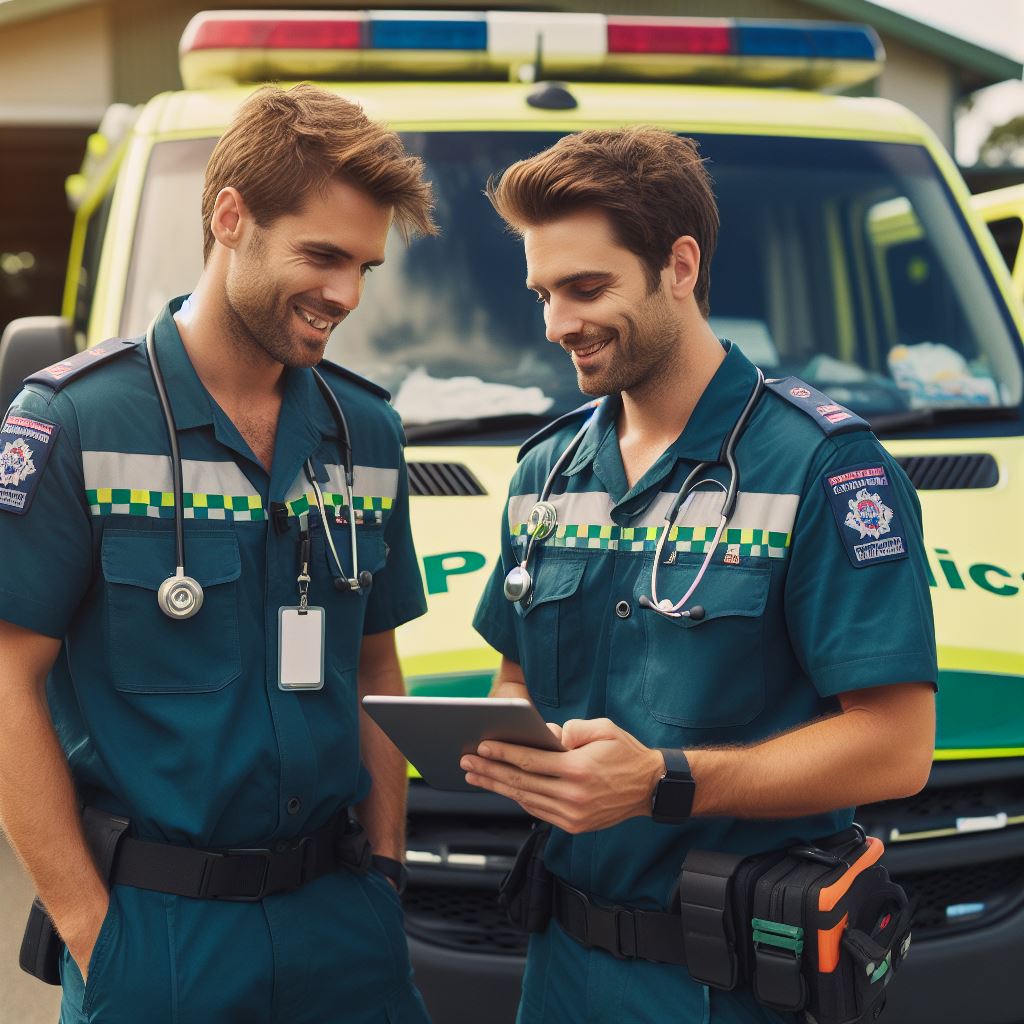Introduction
Welcome to this blog post, where we will explore a typical day in the life of an Aussie paramedic.
Our purpose here is to shed light on the daily activities and responsibilities that paramedics in Australia undertake.
In Australia, paramedics play a critical role in saving lives and providing emergency medical care. They are the first responders to various emergencies, ranging from car accidents to heart attacks.
Each day brings new and unpredictable challenges for these dedicated professionals.
From the moment they start their shift, Aussie paramedics are always on alert, ready to respond to any emergency call.
They work in high-pressure environments, where split-second decisions can be the difference between life and death.
Their day begins with thorough equipment checks and restocking their ambulance. This ensures they have all the necessary tools and supplies to handle any situation that may arise.
Once prepared, they hit the road and tirelessly respond to emergency calls throughout their shift.
Paramedics face a wide range of medical emergencies, from minor injuries to life-threatening situations. They must expertly assess patients, provide immediate medical care, and transport them safely to the hospital.
They administer vital medications, start IV drips, perform CPR, and use advanced medical equipment to stabilize patients.
However, being a paramedic is not just about responding to emergencies.
These dedicated professionals also provide non-emergency services like patient transports between hospitals and medical facilities, as well as conducting community health campaigns and education programs.
In review, a day in the life of an Aussie paramedic is filled with adrenaline, compassion, and the constant pursuit of saving lives.
It is a challenging and rewarding profession that demands quick thinking, resilience, and a deep dedication to serving others.
Through their unwavering commitment, paramedics in Australia make a significant difference in their community every single day.
Overview of a Paramedic’s Role
The role of paramedics in emergency medical care
Paramedics play a crucial role in emergency medical care, providing critical care and saving lives.
They are highly trained professionals who are responsible for responding to medical emergencies and providing immediate medical treatment.
Paramedics have the skills and qualifications required to assess the situation, stabilize patients, and provide necessary medical interventions.
One of the most important aspects of a paramedic’s role is their ability to make quick and accurate decisions under high-pressure situations.
They must be able to assess the severity of the patient’s condition and prioritize their actions accordingly.
The importance of their work in saving lives and providing critical care
A paramedic’s work often involves responding to accidents, cardiac arrests, strokes, and other life-threatening situations.
They must be able to provide initial treatment and stabilize the patient before transporting them to the hospital for further care.
Paramedics are trained to perform a wide range of medical procedures, including administering medications, performing CPR, and managing traumatic injuries.
Your Personalized Career Strategy
Unlock your potential with tailored career consulting. Get clear, actionable steps designed for your success. Start now!
Get StartedThey must also have a comprehensive understanding of the human body and be able to effectively communicate with patients and their families.
The skills and qualifications required to become a paramedic in Australia
To become a paramedic in Australia, individuals must complete a formal training program and obtain the necessary qualifications.
There are several pathways to becoming a paramedic, including completing a Bachelor’s degree in Paramedicine or undertaking an advanced diploma course.
Once the formal education is completed, paramedics must also undergo extensive practical training and gain experience in various clinical settings.
The role of a paramedic requires individuals to possess a range of qualities and skills.
They must have excellent communication and interpersonal skills to effectively interact with patients, their families, and other healthcare professionals.
Paramedics must also be physically fit and able to perform their duties in challenging and unpredictable environments.
They must have the ability to remain calm and composed under pressure and make critical decisions quickly.
Additionally, paramedics must have a strong ethical framework and adhere to strict codes of professional conduct and confidentiality.
Essentially, paramedics play a vital role in emergency medical care. They are highly skilled professionals who are responsible for providing critical care and saving lives.
To become a paramedic, individuals must undergo extensive training and possess a range of skills and qualifications.
Their ability to make quick and accurate decisions under pressure is essential in ensuring the best possible outcomes for their patients.
Paramedics are true heroes, dedicated to providing life-saving care and making a difference in people’s lives every day.
Read: A Day in the Life of a Healthcare Admin in Australia
Stand Out with a Resume That Gets Results
Your career is worth more than a generic template. Let us craft a resume and cover letter that showcase your unique strengths and help you secure that dream job.
Get HiredStarting the Day
Typical start of a paramedic’s day
A typical start of a paramedic’s day often occurs during shift changeovers.
Importance of briefing sessions
Briefing sessions are crucial as paramedics receive important information on ongoing cases. These sessions also provide updates on protocols and ensure equipment checks are done.
Paramedics gather in a designated area to receive handover from the previous shift. They go through patient reports, discussing the current status and any critical changes.
Important details such as allergies, medical history, and medications are shared during handover. Paramedics prepare themselves mentally and physically to face potential emergencies and challenges.
Verify readiness by checking personal protective equipment, such as gloves, masks, and gowns. Ensure ambulances have all necessary medical supplies and equipment through inspections.
The ambulance crew confirms communication systems are working effectively. Shift leaders highlight any specific instructions or updates relevant to the day’s activities.
New protocols or procedures are discussed, ensuring paramedics are up to date with the latest practices. Paramedics may receive information about high-risk cases they might encounter during the shift.
During briefing sessions, senior paramedics offer guidance and answer questions from the team. Team members discuss any potential hazards identified from previous experiences for better preparation.
The importance of maintaining professionalism, teamwork, and effective communication is emphasized. Briefing sessions also provide an opportunity for paramedics to bond and support each other.
Developing camaraderie and unity fosters improved team dynamics, creating an atmosphere filled with anticipation, focus, and determination to save lives.
With the briefing completed, paramedics start the day with a shared sense of purpose and responsibility.
Overall, at the start of a paramedic’s day, they engage in handover, equipment checks, and briefings, preparing mentally, physically, and emotionally to handle emergencies and provide optimal care.
Read: Aussie Paramedics: Career Growth Prospects
Responding to Emergency Calls
How paramedics are dispatched to emergency calls
Paramedics are dispatched to emergency calls either through dispatch centers or direct calls. When an emergency call comes in, paramedics spring into action.
The dispatch center is their main source of information, as it receives emergency calls from the public. However, paramedics can also be directly called by individuals who require immediate medical assistance.
Transform Your LinkedIn for Maximum Impact
Elevate your professional brand with a LinkedIn profile that attracts recruiters, showcases your expertise, and maximizes opportunities. Stand out in your industry with a profile built for success.
Boost ProfileUpon receiving a call, the dispatch center promptly assesses the situation to determine the appropriate response.
They identify the nature of the emergency and gather essential details, such as the location and the caller’s contact information.
This information is then relayed to the paramedics, who are promptly dispatched to the scene.
Prioritizing calls
The process of prioritizing calls is based on the severity of the situation. Prioritizing emergency calls is crucial to ensure that paramedics reach those in critical condition first.
When multiple calls come in simultaneously, paramedics prioritize based on the severity of the situation.
Life-threatening emergencies, such as cardiac arrests or severe injuries, receive the highest priority to maximize the chances of saving lives.
The wide range of emergencies paramedics encounter
During their day-to-day work, paramedics encounter a wide range of emergencies, such as cardiac arrests, injuries, or childbirth.
Cardiac arrests are highly time-sensitive, requiring immediate attention to perform life-saving interventions, such as CPR or defibrillation.
Injuries, including traumatic accidents or falls, often require swift medical assistance to stabilize the patient and prevent further complications.
Childbirth is another emergency scenario that paramedics may encounter. When a pregnant woman goes into labor and there is insufficient time to reach a hospital, paramedics step in to assist with the delivery.
They provide crucial support to both the mother and the newborn, ensuring a safe delivery in a potentially stressful situation.
Paramedics also handle emergencies related to various medical conditions, such as respiratory distress, allergic reactions, diabetic crises, and mental health crises.
Each situation requires a different approach and level of care, showcasing the depth and breadth of paramedics’ skills and knowledge.
Every emergency call is a race against time. Paramedics have to navigate through traffic, follow protocols, and make split-second decisions that can be life-changing.
Their ability to stay calm, focused, and resilient in high-pressure situations is truly commendable.
Paramedics respond to emergency calls through dispatch centers or direct calls, prioritizing based on severity for immediate attention to life-threatening situations.
Paramedics face a wide range of emergencies, including cardiac arrests, injuries, and childbirth, requiring them to showcase their expertise and adapt to each unique situation.
Read: Internship Insights: Becoming an Aussie Paramedic

Arriving at the Scene
As an Aussie paramedic, every day brings new challenges and unpredictable situations. The moment we receive a call, we race towards the scene with lights flashing and sirens blaring.
The paramedic’s arrival at the scene
Upon arrival, we quickly assess the situation using our training and experience. We must make split-second decisions to stabilize patients and provide immediate care. Time is of the essence, and every second counts.
Adhering to protocols, maintaining calmness, and ensuring scene safety
Adhering to protocols is crucial in our line of work. We follow strict guidelines to ensure we provide the highest standard of care.
This not only ensures the best outcomes for our patients but also maintains our professionalism and credibility within the medical community.
Remaining calm amidst chaos is a skill that every paramedic must master. We understand that panic and chaos at the scene can hinder our ability to save lives.
Our composed demeanor helps reassure patients and their loved ones in times of crisis.
Ensuring scene safety is paramount. We assess potential hazards and take necessary precautions before entering the scene.
This includes securing the area, identifying potential risks, and communicating with other emergency responders.
The utilization of medical equipment and tools to provide appropriate care
Our medical equipment and tools are our lifelines. We rely on them to accurately assess patients’ conditions, monitor vital signs, and provide appropriate care.
From stethoscopes and blood pressure cuffs to defibrillators and advanced airway devices, our equipment allows us to make critical interventions.
Each patient we encounter is unique, and we must adapt our approach accordingly.
Whether it’s administering medication, bandaging wounds, or performing CPR, we use the tools at our disposal to provide the most effective care possible.
Communication is key throughout the entire process. We interact with patients, their families, and other healthcare professionals to gather crucial information and coordinate our efforts.
Clear and concise communication ensures efficient teamwork and optimal patient outcomes.
A day in the life of an Aussie paramedic is never predictable. We face a wide range of emergencies, from minor injuries to life-threatening situations.
Our arrival at the scene marks the beginning of a challenging yet fulfilling journey to save lives and make a difference in our community.
In Summary, arriving at the scene involves quick assessments and immediate actions to stabilize patients. Adhering to protocols ensures the highest standard of care and maintains professionalism.
Remaining calm and ensuring scene safety are crucial in providing effective care. Medical equipment and tools are essential for accurate assessments and interventions.
Effective communication with patients, families, and healthcare professionals is vital throughout the process.
Read: Continual Learning for Australian Paramedics
Providing Medical Assistance
Medical Procedures and Interventions
In their daily work, Aussie paramedics perform a multitude of medical procedures and interventions to save lives and provide critical care to patients.
- CPR: Cardiopulmonary Resuscitation is a vital procedure performed to restore blood circulation and respiration in patients experiencing cardiac arrest.
- Administering Medications: Paramedics have the authority to administer medications, both orally and intravenously, to alleviate pain, treat illnesses, and stabilize patients.
- Immobilizing Injuries: When faced with patients who have suffered traumatic injuries, paramedics utilize various methods to immobilize and stabilize affected body parts to prevent further damage.
These procedures require a high level of skill, knowledge, and training from paramedics. Their ability to effectively perform these interventions under pressure is paramount to the survival and recovery of patients.
The Importance of Effective Communication and Collaboration
Paramedics understand that providing medical assistance extends beyond performing procedures; effective communication and collaboration play integral roles in their daily interactions.
When arriving at the scene, paramedics must quickly establish rapport and communicate with patients and their families.
They must gather essential information about the patient’s medical history, allergies, and current condition to make informed decisions regarding treatment.
Furthermore, collaboration with other healthcare professionals on the scene is crucial. Paramedics work closely with doctors, nurses, and firefighters to effectively manage complex cases.
They exchange critical information, delegate tasks, and coordinate efforts to provide comprehensive care to patients.
Effective communication and collaboration also extend to the hospital setting.
Once paramedics hand over patients to the medical team, they provide detailed reports and updates on the patient’s condition, treatment provided, and any changes observed during transport.
This allows for a smooth transition of care and ensures continuity in patient management.
Paramedics also engage in ongoing communication and debriefing sessions with their peers and supervisors.
These discussions help them process challenging cases, share valuable experiences, and learn from one another.
In a nutshell, being an Aussie paramedic involves more than just responding to emergencies.
It requires proficiency in various medical procedures and a strong emphasis on effective communication and collaboration.
Their ability to perform CPR, administer medications, and immobilize injuries is essential in saving lives.
By effectively communicating with patients, families, and healthcare professionals, paramedics ensure a holistic approach to patient care.
Paramedics truly make a difference in the lives of those they assist, utilizing their skills and expertise to provide timely, lifesaving medical assistance to the Australian community.
Transporting Patients and Handovers
Paramedics play a crucial role in patient transportation, ensuring ongoing care is provided en route to the hospital.
Additionally, accurate patient documentation and effective handovers are essential for seamless continuity of care. Paramedics also have a responsibility to maintain patient confidentiality and privacy.
Handling Patient Transportation and Ongoing Care
- Paramedics are trained to handle various medical emergencies and transport patients safely to the hospital.
- They carefully assess the patient’s condition and provide necessary treatments and interventions during transportation.
- This may include administering medications, managing airways, providing cardiac monitoring, and controlling bleeding.
- Paramedics stay alert throughout the journey, constantly monitoring the patient’s vital signs and responding to any changes.
- They communicate with the receiving hospital and provide updates on the patient’s condition, ensuring appropriate preparations are made.
- Ensuring patient comfort and minimizing discomfort during transportation is also a priority for paramedics.
- They use specialized equipment, such as stretchers, securing patients properly to ensure safety.
- Throughout the journey, paramedics offer reassurance and emotional support to patients and their families.
Importance of Accurate Documentation and Effective Handovers
- Paramedics understand the significance of precise patient documentation to ensure proper continuity of care.
- They meticulously record vital information, including the patient’s medical history, current condition, and treatments provided.
- Accurate documentation helps healthcare professionals in the receiving hospital make informed decisions.
- Handovers are crucial moments where paramedics transfer care to hospital staff, ensuring a seamless transition.
- Effective handovers involve providing a comprehensive overview of the patient’s condition, treatments administered, and any changes observed.
- Paramedics communicate vital sign trends, test results, and interventions performed during transportation.
- Clear and concise handovers support the receiving hospital team in determining the appropriate course of treatment.
Maintaining Patient Confidentiality and Privacy
- Paramedics have a legal and ethical obligation to protect patient confidentiality and privacy.
- They strictly adhere to privacy policies and treat all patient information with the utmost confidentiality.
- Paramedics ensure that conversations regarding the patient’s condition are held privately, away from public earshot.
- They maintain the privacy of patient records and ensure they are securely stored and accessed only by authorized personnel.
- Paramedics also follow strict protocols when sharing patient information with healthcare professionals during handovers.
- Respecting and safeguarding patient confidentiality builds trust, ensuring patients feel comfortable seeking medical assistance.
Basically, transporting patients and conducting handovers are critical aspects of an Aussie paramedic’s role.
They provide ongoing care, accurately document patient information, and prioritize patient confidentiality and privacy.
These practices contribute to the seamless continuity of care and the overall well-being of patients.
Post-Scene Activities
After responding to a call and providing the necessary medical care, paramedics have several post-scene activities to attend to.
These activities are crucial in ensuring the smooth running of their operations and the well-being of both themselves and their patients.
Completion of Paperwork and Reporting
- After safely transporting the patient to the hospital, paramedics must promptly complete all required paperwork and reporting.
- This includes accurately documenting the details of the incident, the medical assessment, treatment provided, and any medications administered.
- Proper documentation is essential to maintain accurate patient records and ensure continuity of care.
- Paramedics must adhere to strict guidelines and protocols while completing these reports to ensure compliance with legal requirements.
Restocking Supplies and Cleaning Equipment
- Paramedics need to restock their medical supplies and clean their equipment thoroughly after each call.
- This involves checking their stock levels and replenishing any used or expired items.
- Having well-stocked and clean equipment is vital for them to provide efficient and effective care during the next call.
- Regular equipment cleaning also helps prevent the spread of infectious diseases and maintain a sterile environment.
Importance of Self-care and Debriefing Sessions
- The nature of their job exposes paramedics to various stressful and emotionally challenging situations.
- To address this, self-care and debriefing sessions are essential to help them cope with the emotional toll and potential trauma.
- Paramedics often engage in debriefing sessions with their peers or professional counselors to discuss their experiences and emotions.
- These sessions provide a safe and supportive environment for them to express their feelings, reflect on their actions, and seek guidance if needed.
- Additionally, practicing self-care, such as engaging in hobbies, exercising, and spending time with loved ones, helps paramedics maintain their mental and emotional well-being.
Ultimately, post-scene activities play a significant role in the life of an Aussie paramedic. Completing paperwork and reporting ensures accurate documentation and legal compliance.
Restocking supplies and cleaning equipment are vital for providing quality care. Self-care and debriefing sessions help address the emotional toll of the job.
By prioritizing these activities, paramedics can continue to serve their community effectively while taking care of themselves.
See Related Content: Internships for Med Tech Students in Oz
See Related Content: Medical Technician Specialties in Australia
Conclusion
In closing, being an Aussie paramedic is no easy task. It requires dedication, commitment, and a strong sense of responsibility.
Paramedics face challenging situations daily, from life-threatening emergencies to providing critical care in a fast-paced environment.
They work long hours, sacrifice personal time, and undergo rigorous training to ensure they can handle any situation that comes their way.
The daily life of an Aussie paramedic entails responding to emergency calls, assessing patients, administering life-saving treatments, and transporting them to the hospital.
They work in highly stressful conditions and make critical decisions that can mean the difference between life and death.
Despite the challenges, paramedics remain steadfast in their mission to save lives and provide the best possible care for their patients.
It is important for readers to appreciate the invaluable service provided by paramedics in their communities.
They are the first responders to medical emergencies, providing immediate care and stabilizing patients before they can reach the hospital.
Through their selfless dedication, paramedics save countless lives and improve the outcomes of patients in need.
Let us not forget to support and show gratitude to the paramedics who dedicate their lives to saving others.
Their commitment to providing emergency medical care is nothing short of extraordinary.
So, the next time you see an ambulance rushing by or a paramedic in action, take a moment to acknowledge their hard work, sacrifice, and the immeasurable impact they have on our communities.
We owe them a debt of gratitude for their unwavering service and dedication.




